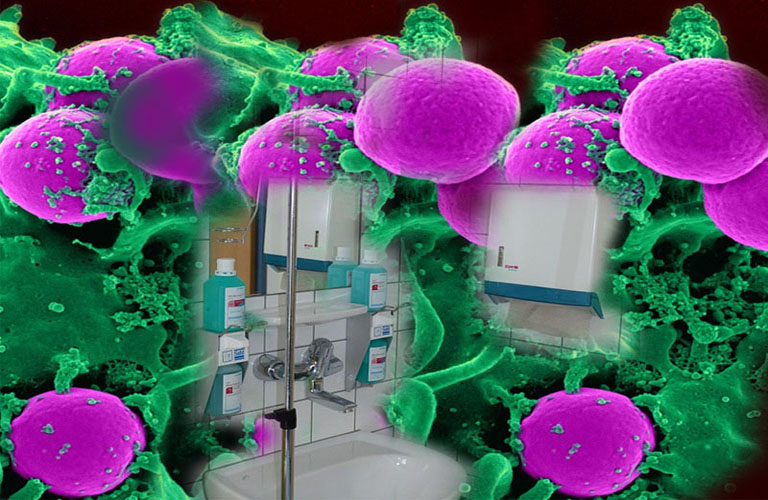MRSA Infections
Methicillin-resistant Staphylococcus aureus (MRSA)
Methicillin-resistant Staphylococcus aureus (MRSA) is a type of bacteria that is resistant to certain antibiotics. These antibiotics include methicillin and other more common antibiotics such as amoxicillin, oxacillin and penicillin. Staph infections, including MRSA, occur most frequently among persons in hospitals and health care facilities (such as nursing homes and dialysis centers) who have weakened immune systems.
Serious MRSA disease is still predominantly related to exposures to health care delivery:
- About 85% of all invasive MRSA infections were associated with health care, and of those, about two-thirds occurred outside of the hospital, while about one third occurred during hospitalization.
- About 14% of all the infections occurred in persons without obvious exposures to health care.
Although the rates of disease varied between the geographically diverse sites participating in the surveillance, overall rates of disease were consistently highest among older persons (age >65), Blacks, and males.
Staph and MRSA can also cause illness in persons outside of hospitals and healthcare facilities.
Basic infection control practices are key to the prevention and control of MRSA in healthcare settings. The following resources provide recommendations for the prevention and control of many health-care-associated diseases and infections including infections with drug resistant organisms such as MRSA.
Find out more about healthcare associated infections...

"Good health and good sense are two of life’s greatest blessings."
~ Publilius Syrus
Community Associated MRSA or CA-MRSA Infections
MRSA infections that are acquired by persons who have not been recently (within the past year) hospitalized or had a medical procedure (such as dialysis, surgery, catheters) are know as Community Associated MRSA or CA-MRSA infections.
Staph or MRSA infections in the community are usually manifested as skin infections, such as pimples and boils, and occur in otherwise healthy people.
The topic of MRSA that has been in the news quite a bit is related to schools. Over the past several years, MRSA has emerged in the school community as one of the most common causes of skin infections. These infections may appear as small pustules or boils, which are often red, swollen, painful, or have pus associated with them. They commonly occur at sites of visible skin trauma, such as cuts or abrasions, or can occur at sites commonly covered by hair on the body, like the back of the neck, groin, buttock, armpit, or the bearded area of men. It's also important to mention that although rarely occurring in healthy people, more serious infections can occur, such as pneumonia, bloodstream infections, and bone infections. However, most of the life-threatening MRSA infections are associated with health care.
We sometimes hear MRSA referred to as a “super bug” in the media. That doesn't mean that MRSA has no cure. There are still a number of antibiotics available for treatment. The infections we hear about happening in schools are MRSA skin infections and most of these infections may not need antibiotics at all. Usually, the first-line treatment for these skin infections is drainage. And of course, drainage of these skin infections should only be done by your healthcare provider. Click Here for MRSA Overview...
MRSA Infection Prevention and Control
MRSA is usually transmitted by direct skin-to-skin contact or contact with shared items or surfaces that have come into contact with someone else’s infection, for example, a towel you might use for bathing or used bandages. Certain factors have been associated with making it easier for MRSA to be transmitted. These factors include crowding; frequent skin-to-skin contact; compromised skin, such as cuts and abrasions; contaminated items or surfaces; and lack of cleanliness. Some settings where these factors are common include schools, dormitories, military barracks, households, correctional facilities, and daycare centers. Now while MRSA infections are commonly reported from these settings, it’s important to emphasize that MRSA is a prevalent cause of skin infections in the general community and can occur essentially anywhere.
There are a number of things that people can do to protect themselves—many simple measures. The first and probably the most important step is to practice good hygiene:
- Keep your hands clean by washing thoroughly with soap and water or using an alcohol-based hand sanitizer.
- Keep cuts and scrapes clean and covered with a bandage until healed.
- Avoid contact with other people’s wounds or bandages.
- Avoid sharing personal items such as towels or razors.
It’s also important, if you participate in activities where there is frequent skin-to-skin contact, like exercise or sports, you should shower immediately after participating in those activities. Also, people should cover all their skin cuts and abrasions, to prevent them from getting infected. They should be covered by clean, dry bandages until healed.
Everyone should avoid sharing all personal items that come into direct contact with bare skin and barrier-like clothing or a towel should also be used between skin and shared equipment like weight-training benches. And finally, high-touch surfaces or surfaces that you frequently contact with your hands should be kept clean, and also other surfaces that might come into direct contact with people’s skin should be cleaned routinely.
For more information about MRSA, please check Invasive MRSA Fact Sheet (pdf)





